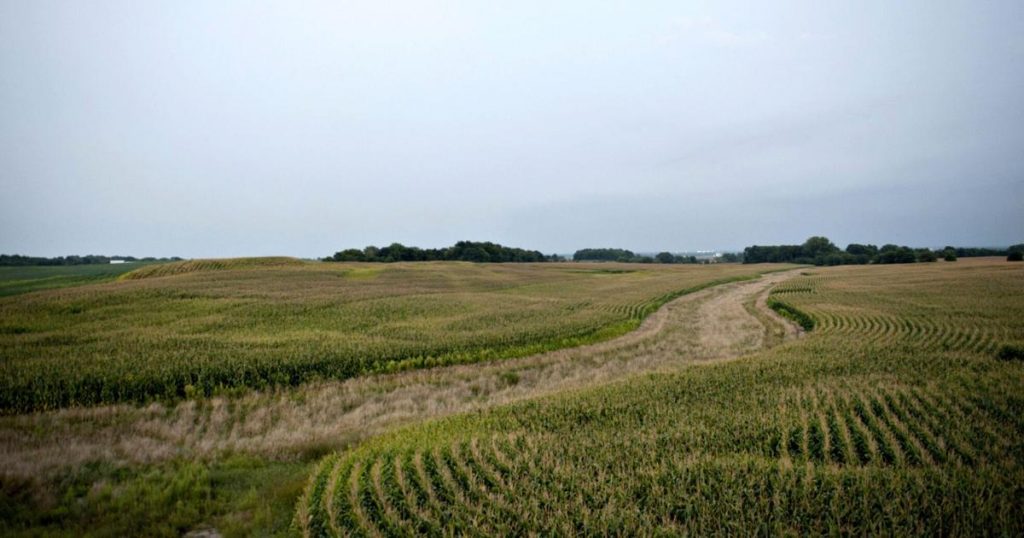Buying land in rural America has never been more expensive. And that’s even with soaring interest rates.
Rising commodity prices mean farmers have earned record sums this year, spurring a rush for space to plant in 2023. Increased demand comes just as people have fled to the countryside for the pandemic – with non-metropolitan areas growing faster than urban areas – and investors turned to fields as a hedge against inflation.
Farmland prices in the Midwest, the country’s breadbasket, jumped 20% in the third quarter from a year earlier, thwarting a slowdown in the residential real estate market, according to data from the Federal Reserve Bank of Chicago. and the National Association of Realtors. It was the eleventh straight quarter of gains, the longest streak since 2014.
Jim Schultz, who runs Open Prairie, a private equity investment firm in central Illinois, estimates farmland prices could double in the next 10 years. That’s after the 13,000 acres he bought between 1987 and 1992 for $750 an acre are now worth 16 times as much.
“I believe we’re at the beginning of a trend that’s been going on for a decade,” said Schultz, who says he has no interest in selling. “We are in a very good position.
Producers across the United States are making more money as Russia’s invasion of Ukraine chokes off the supply of a key producer of everything from corn to wheat and sunflower oil. Rising prices have taken farmers’ profits to nearly $161 billion this year, a 14% increase from 2021, according to estimates from the US Department of Agriculture.
The increase in demand for agricultural land coincides with the population changes induced by the pandemic. The number of people living in non-metropolitan counties rose 0.3% in the 12 months to July 2021, the first time that rural population growth has exceeded that of urban areas since the mid-1990s. according to the USDA.
Tom Halverson, chief executive of CoBank, a cooperative lender serving rural America, said the expansion of broadband and the ability to work from home have helped fuel that change.
“The reality is that for the first time in several decades, rural America is growing its population,” he said on Bloomberg TV this month. “We hope and expect it to be somewhat structural, but it will be unevenly distributed across the country.”
Farmland has also become more attractive as homeowners seek to make money from switching to clean energy. Demand for renewable diesel — made from vegetable oils but with identical chemical properties to petroleum-based fuel — is expected to triple over the next five years, according to BloombergNEF.
Growers also have space for solar panels and wind turbines, with the number of farms with photovoltaic installations doubling in the five years to 2017, according to the latest USDA Agricultural Census. Yet farmland with renewable assets only accounted for 6.5% of the total, highlighting untapped potential.
Growers can also now take advantage of carbon sequestration, the price Indigo Ag pays farmers for doubling carbon over the past two years.
Certainly, rising rates and a possible recession in the United States next year could still affect the farmland market.
Prices for grade A plots in Illinois could drop between 2% and 5% next year, according to Luke Worrell, a farmland broker in the city of Jacksonville.
“Between diminishing returns and higher interest rates, you’re hitting your two main buyers of farmland. It’s a double,” Worrell said in an interview. “We had a wild ride, but we would be naive to think it will go on forever. We have to be prepared for a bit of softening.
Matthew Fitzgerald, who grows organic corn and soybeans with his family in McLeod County, Minnesota, said the biggest challenge for young farmers is the cost of land. He has leveraged a USDA program to expand his family’s 200 acres to around 2,500 acres, and is partnering with farmland investment platform AcreTrader, which buys land which he then manages and in which it co-invests.
“With farmland prices at these levels, it’s a total headache of how to be competitive and how to acquire land,” Fitzgerald, 31, said by phone. “Grassroots farming in the Midwest is a lot like the Mafia – you have to know someone or have a lot of money.”
In the long term, a growing world population coupled with a changing climate makes the productive lands of the Midwest an integral part of global food production.
Interest from outside investors is also on the rise. Farmland is considered an excellent hedge against inflation, as the products it produces generally increase in value when overall prices rise.
“Land is a real asset,” University of Illinois professor Gary Schnitkey said at a conference in Champaign. “Do you want to own a piece of land or a cryptocurrency? It’s a good way to diversify your asset portfolio.
Bloomberg’s Tarso Veloso contributed to this report.
